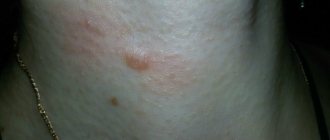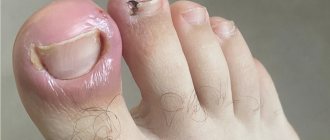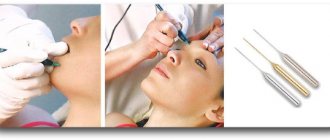Causes of papillomas
It is believed that up to 70% of the entire population of the planet is infected with the human papillomavirus. Often, based on the results of the analysis, it becomes clear that a person is infected with 20 strains of the virus at once. But often the virus does not manifest itself for a long time, especially if the person has good immunity.
A non-specialist is unlikely to determine the type of neoplasm on the skin “by eye”
Infection with any of the HPV strains most often occurs through direct contact with a carrier of the virus, in which the pathogen can penetrate microtraumas on the skin and mucous membranes. The neoplasm forms directly at the site where the virus enters the body. The anogenital form of the disease is transmitted during sexual intercourse, in this case papules form in the folds of the skin of the perineum, on the mucous membranes of the vagina and cervix, in the rectum, urethra and bladder, and in men - on the head of the penis. On the outside, genital warts are mainly formed, and on the internal organs - flat papillomas. The oral cavity can be infected in a similar way. In this case, laryngeal papillomatosis occurs, affecting the mucous membranes of the mouth and throat.
A newborn can become infected with HPV from the mother during passage through the birth canal. In this case, the child most often develops anogenital papillomatosis, the strain of which is the most aggressive, or laryngeal, which can significantly damage the child’s vocal apparatus in the future and can even be life-threatening in severe cases due to airway obstruction.
However, to become infected with HPV, it is not necessary to have direct contact with the carrier. The virus can exist for some time outside the host’s body and be transmitted through household objects or in public places. Simply put, sometimes it is enough to hold on to the handrail in public transport and then touch your face, so that in a year or two a new growth will appear in that place.
Since the incubation period of the papillomavirus is quite long, several months or even years may pass from the moment of infection to the appearance of clinical signs. Usually the virus is activated and begins to manifest itself in the form of neoplasms when immunity decreases. That is why treatment should include not only the removal of visible manifestations of HPV, but also systemic immune therapy.
Indications for removal
To remove papillomas of varying complexity, you can contact Medline-Service. The indication for the procedure is any growth that carries the possibility of degeneration. To a large extent, this applies to papillomas that are located in places of constant contact with clothing. Formations that have a suspicious appearance, as well as those that spoil a person’s appearance, are also subject to removal. To prevent complications, it is necessary not only to eliminate the growths, but also to consult a specialist for comprehensive treatment of the papilloma virus.
Types of tumors caused by HPV
Not all clinical manifestations of papillomatosis are the same. Today, about 90 HPV strains have been typed and correlated with certain types of neoplasms. Based on the external manifestations of the disease, the following types of papillomas are distinguished:
- plantar papillomas, often called warts;
- simple, or vulgar, papillomas;
- flat papillomas;
- genital warts;
- filamentous papillomas.
Even a doctor cannot always make an accurate diagnosis based on appearance
Plantar warts
As the name suggests, plantar warts form on the skin of the feet and are characterized by internal growth, which distinguishes them from other types of neoplasms. They are usually solitary, but if left untreated they can reach impressive sizes, causing considerable discomfort.
Vulgar papillomas
Vulgar papillomas are also often called warts in everyday life. They grow from a small tubercle, gradually enlarging and darkening due to keratinization, and can merge with each other into formations of an indeterminate shape. Papillomas of this type are most often localized on the skin of the hands, less often on the knees, face, neck, and back. Like plantar pain, they can go away on their own.
Flat papillomas
Flat papillomas rise slightly above the skin, and their surface has a nodular structure. These neoplasms are not subject to keratinization (keratinization) of the surface, so they usually retain the color of healthy tissue or become slightly darker. They can appear on the face in the eye area and on the chin, as well as on the lower legs, arms, and back. A common symptom of vulgar papillomas is itching. Such neoplasms do not go away on their own, and an accurate diagnosis must be made by a doctor.
Condylomas acuminata
Genital warts are similar in appearance to cauliflower. Single neoplasms grow on a thin stalk, gradually merging with each other into large growths. Condylomas are localized in the anogenital area:
- on the external and internal genital organs;
- outside and inside the anus;
- in the perianal fold;
- in the urethra and bladder.
These neoplasms are precancerous and therefore must be removed, followed by subsequent therapy based on test results. Suffice it to say that in almost 80% of cases, cervical cancer is detected by this type of human papillomavirus.
Filiform papillomas
Filiform papillomas, otherwise called acrochords, grow on a thin stalk, which makes them easy to accidentally tear off, and are predominantly single, less often found in groups. Their main locations are the face in the area of the eyes and nose, inguinal folds, axillary areas and under the breasts in women. They usually have an oblong, elastic shape without keratinization. Rubbing with clothing can cause discomfort and damage. Acrochords cause mainly aesthetic discomfort and are susceptible to malignancy in rare cases.
An accurate diagnosis can be established using laboratory methods for studying tumors
Moles: a source of charm or fear?
Three main postulates:
- Most moles do not pose any danger. Nevus can develop into melanoma, the most dangerous type of skin cancer. But the likelihood of such a rebirth is very small. Melanomas most often appear suddenly on completely healthy skin.
- Moles can be removed. Contrary to popular belief, surgical removal of a nevus does not create any risk of malignant degeneration. It makes sense to remove moles when they disfigure a person’s appearance or bother a person for some other reason, or, of course, in cases where there is reason to doubt their benignity (for diagnostic purposes). Finally, it is believed that care should be taken not to traumatize the moles.
- You should consult your doctor:
- a recently noticed change in the color or shape of a mole, bleeding from it.- the appearance of a new brown spot, rapidly increasing in size and noticeably different from other moles.
— birthmarks of patients at risk. They must be carefully inspected periodically. The risk group includes those who have a lot of moles, who have already had melanoma or have had melanoma in their relatives, as well as those who have a lot of moles, who have very white skin, who have suffered a sunburn.
Diagnosis of papillomas
No matter how much you would like to get rid of annoying papilloma quickly and at home, or even better - with the help of some folk remedies, do not rush! Self-selecting procedures can lead to disastrous results. Be sure to visit your local clinic.
In a paid clinic, for your money, they will cut/burn/freeze anything for you without any questions asked, but there is no guarantee of an accurate diagnosis, and therefore the absence of undesirable consequences.
Only a qualified specialist can make an accurate diagnosis and prescribe appropriate treatment. Be sure to take the tests prescribed by your doctor before getting rid of tumors. First of all, you need to get advice:
- a gynecologist or urologist if tumors appear in the perineal area;
- an otolaryngologist if papillomatosis of the mucous membranes of the mouth or throat is suspected;
- a dermatologist - in all other cases.
Based on the results of the clinical examination, the doctor, if necessary, may prescribe:
- collection of cells for cytological examination;
- tissue sampling for histology;
- scraping for PCR analysis;
- collecting material for the daijin test.
All these methods, in one way or another, make it possible to determine the risk of developing cancer. After removing the tumors by any method, it will no longer be possible to determine this indicator. This increases the likelihood of adverse consequences.
Where to go to remove papillomas and condylomas in Vladivostok?
To carry out the procedure for removing an unwanted tumor, you should contact the Clinic on Komarova. But how to choose from the variety of public and private clinics the one that will provide the service of the required quality at an affordable price?
It is worth choosing a clinic where they can provide a range of services: both for diagnosis and treatment. Pay attention to the level of equipment of the clinic, the level of service and, of course, the pricing policy.
The clinic on Komarova is equipped with the latest equipment. For example, diagnosis of neoplasms is carried out using SEAscope. The clinic provides a wide range of medical services: from diagnostic to surgical treatment. At the same time, we maintain affordable prices and a humane attitude towards each patient.
Chemical destruction
It is carried out using special liquid preparations based on acid or creams containing alkali. Such drugs are sold in pharmacies as prescribed by a doctor.
This method can be used to remove only single vulgar papillomas (warts) on the hands.
However, the slightest inaccuracy in the use of chemotherapy can lead to burns of healthy tissue or incomplete removal of the tumor. The use of such products is painful, time-consuming, does not provide a guaranteed result and can lead to the formation of unsightly scars at the site of the tumor.
When using chemicals to combat tumors, special precision is required
At-risk groups
The risk group for infection and relapse includes the following categories of people:
- having promiscuous sexual intercourse;
- those who have had a long-term serious illness;
- pregnant women;
- alcohol and cigarette abusers;
- subject to frequent stress;
- not watching their diet (eating unhealthy foods containing dyes, flavors, preservatives and other additives);
- taking medications for a long period of time.
Don't risk your health! Make an appointment with Medline-Service specialists in Moscow - we will do everything possible to help you return to a healthy life.
Cryodestruction
A long-established and well-proven method of removing tumors using exposure to extremely low temperatures, in which the affected area is exposed to liquid nitrogen or other refrigerant for a short time.
The application of the refrigerant itself does not require preliminary anesthesia, because The application is painless, although the patient may feel a slight tingling or burning sensation. However, after the operation, during the “unfreezing” of the tissues, acute pain occurs, which can last up to a day. This is normal.
After a few hours, redness and swelling form around the injury, and a day later a subcutaneous blister filled with fluid forms. The rehabilitation period lasts a week, during which the swelling and hyperemia disappear, and the bladder breaks on its own. After this, it is necessary to apply an antiseptic drug prescribed by a specialist.
The death of tissue under the scab continues for three weeks, which ensures reliable destruction of infected tissue. Wound healing occurs in 1.5 months, and the mark completely disappears in six months, during which it is necessary to protect the skin from the sun and mechanical stress.
The method is successfully used to remove papillomas on the body, in the oral cavity and for the treatment of the cervix. But to remove tumors on the face and intimate area, it is better to use another method. In the first case - due to swelling and hyperemia, in the second - due to increased pain sensitivity of the genital area.
Can there be complications?
If papillomas are removed correctly and appropriate skin care is provided after surgery, then complications should not arise. By contacting Medline-Service, you can be confident in the professionalism of the doctors, the modernity of the equipment and the complete sterility of the procedure. The only consequence that may occur is a complication after pain relief. If you are allergic to any medicine, you must inform your doctor.
Radio wave coagulation
Removal of tumors with a radioknife occurs under the influence of directed high-frequency radiation, during which the affected tissue evaporates. The radiotherapy device has several electrodes of various shapes and purposes, which the doctor selects depending on the form of the tumor. The most widely used device in our country is the Surgitron device.
The procedure is performed under local anesthesia in the form of an injection. With this method, papillomas are removed quickly, without damaging healthy tissue, leaving almost no traces. There is no rehabilitation period here, but there are many contraindications to the use of this method. Radioknife is contraindicated for:
- exacerbation of chronic diseases;
- acute inflammatory processes;
- diabetes mellitus;
- pregnancy and lactation;
- presence of a pacemaker;
- oncological diseases of any location.
Radio wave treatment should not be used if there is a possibility of malignancy of papillomas. But in the absence of such, the method is successfully used on any part of the body. According to patients, the most unpleasant thing about this procedure is the anesthetic injection.
Post-procedure care
For a quick and complete recovery and to avoid possible complications, the following measures are recommended:
- avoid contact with water in the first 2-3 days;
- Do not remove the crust that has formed (it will fall off on its own);
- Treat the wound with an antiseptic 2 times a day;
- protect the manipulation site from injury;
- wounds and new skin formed must be protected from ultraviolet radiation;
- refrain from shaving and epilation if the papilloma was in this area until complete healing.
Laser coagulation
The modern non-contact method of removing tumors using a laser has become widespread not so long ago. Experts say that it is absolutely painless and low-traumatic, because... infected tissues evaporate without harming healthy ones. The procedure takes a few minutes, and the rehabilitation period lasts 2 weeks, during which you should refrain from swimming in the pool and open water, and avoid temperature changes and the sun.
The method can cause side effects such as prolonged skin redness and swelling; in case of thyroid problems, keloid scars can form. There are many contraindications for this type of treatment:
- diabetes;
- acute inflammatory processes;
- epilepsy;
- disorders of the endocrine and immune systems;
- photoderomatosis;
- thrombocytopenia and others.
According to patients, the procedure is very unpleasant and painful, and during the process “you can smell the smell of burnt meat.” In addition, healing takes a long time and relapses are possible.
Electrocoagulation
With any method of removing papillomas, there is a certain rehabilitation period.
It is used to remove small papillomas. Since the essence of the method is the thermal destruction of the affected tissue, the method is popularly called “cauterization.” A heated electrode is used to touch the neoplasm and coagulate it along with the vessels, resulting in a pinpoint burn that becomes covered with a dark crust within an hour. In the case of single papillomas, local anesthesia is used, but in the case of multiple small tumors this is inappropriate.
The rehabilitation period lasts about a week, during which the redness and swelling disappear and the dark crusts disappear. At this time, it is recommended to protect yourself from the sun and treat your skin with an antiseptic.
The use of this method is possible for any location of tumors, and patient reviews indicate its reliability. While the price for removing one papilloma is very reasonable, removing multiple tumors will cost a pretty penny.











